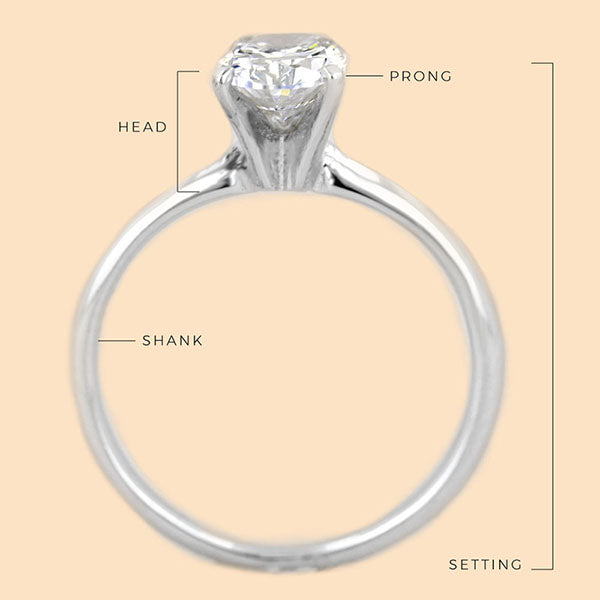Anatomy of a Ring: Designs & Terminology
When it comes to shopping for a ring, there are many different features to consider. While it’s important to know exactly what you want, it’s also important to know the definition of each different part of the ring. This ring terminology is especially useful when it comes to choosing from a range of options, whether there's minimal customization or complete custom designing. In order to help you understand each part of a ring and make it easier to communicate this to your personal shopper, or even drop a hint to that special someone, we’ve put together this handy visual guide.

Setting: The setting is the entire ring, including stones.
Head: The head is the portion of the ring that holds the center stone.
Shank: The shank is the metal portion of the ring that goes around the finger, starting and stopping at the head.
Prong: A prong is a metal tip, bead or arm that holding the stone in place. This style of setting usually has four or six prongs. Prong settings expose the girdle, allowing the maximum amount of light to enter a stone from all angles. Other prong styles include double prong, claw prong, v-tip, and three prong martini.

Prong Head: The prong head is the piece of metal that secures the center stone to the ring. Four prong is the most common type of prong head with five or six prongs are typically used depending on the size or shape of the center stone.
Cathedral: A cathedral setting is a style of ring where either side of the band arches up and reaches towards the center stone.

Bezel: A style of setting that uses no prongs and instead is designed with a rim of metal holding the stone(s). The surrounding metal only leaves the upper portion, above the girdle, visible. Bezels can be plain metal or accented with diamonds or gems and often have smooth edges, but can be scalloped or molded into any shape to accommodate the stone.
Side Stones: Not to be confused with accenting stones on the band, side stones are set on either side of a center stone - typically above 0.20ct in size.

Halo: The halo is a part of an engagement ring that encircles the center stone. A halo can be any shape and is accented with diamonds or gemstones. Halo designs accentuate the center stone making it appear half to one carat larger.

Basket Head: A basket head is a type of prong setting that looks similar to a basket. It provides increased support and stability for the center stone, especially those more than 2.0ct in size. Viewed from the side, basket heads can have one or two horizontal bars or can be quite ornate.
Hidden Halo: A hidden halo is a full circle of diamonds set below the center stone in the gallery.
Pavé: A pavé setting is a band that appears to be paved with tiny diamonds. Pavé settings use small prongs or beads to hold the diamonds in place, leaving very little metal exposed.
Micro-Pavé: A micro-pavé setting is similar to a pavé setting where the band appears to be paved with tiny diamonds. The difference is that micro-pavé settings use even smaller prongs or beads to hold smaller diamonds in place, leaving very little metal exposed.
Eternity: Also referred to as “full eternity”. This is when a ring’s pavé, micro pavé or accenting side stones extend all the way around the band without any plain metal showing.

Gallery: The gallery is the area between the center stone head and shank. It is oftentimes accented with diamonds, beading or filigree if not left plain.
Filigree: Filigree is a stylistic embellishment that can be found on the shank or gallery/head of the ring using spiral or twisted designs, usually seen on antique style rings.
Milgrain/Beading: Milgrain, also known as beading, are the small beads of metal used to accent the edge of a setting or add pattern or adornment to features like a halo and bezel. This detail is most often seen as an embellishment on antique or vintage-inspired rings.
To learn more about frequently used terminology in reference to diamond rings and jewelry, check out our Glossary of Terms.


